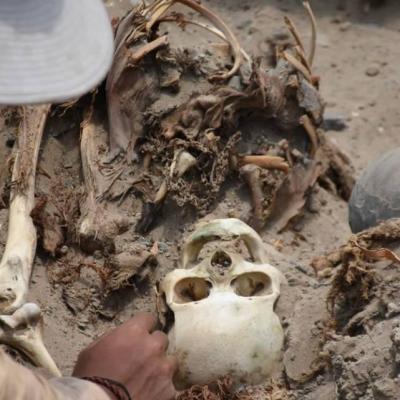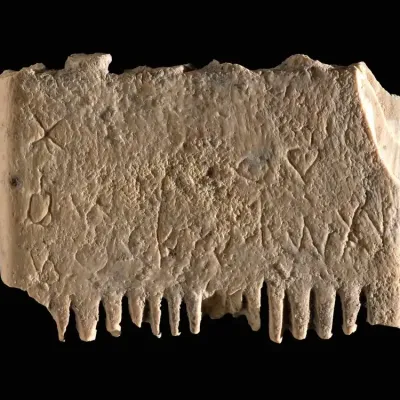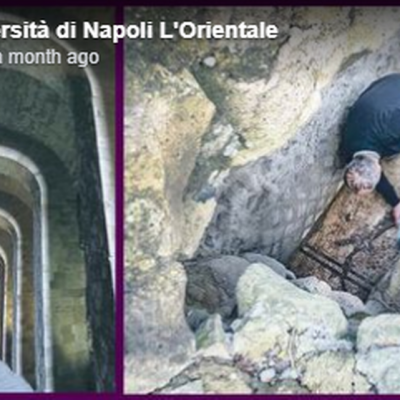INSTITUT SUPERIEUR D'ANTHROPOLOGIE
INIINSTITUT SUPERIEUR D'ANTHROPOLOGIE
NSTITUT SUPERIEUR D'ANTHROPOLOGIE
STITUTE OF ANTHROPOLOGY
ONLINE COURSES / COURS A DISTANCE
DEBUT COURS : AVRIL 2023
REGISTER NOW
IRAQ –  Girsu - Photographs taken by CIA spy-planes during the cold war have been used to help uncover a long-lost palace buried beneath the Iraqi desert. Archaeologists, led by experts from the British Museum, are working on the site of the ancient city of Girsu which dates back 4,500 years to the height of the Sumerian civilisation - credited with building the world’s first cities and establishing written language. The project, which is also funded by the Getty Museum, has uncovered an ancient temple and hundreds of tablets covered in cuneiform writing which shed light on the lost civilisation. Girsu would have been home to around 30,000 people and Dr Rey said the palace was “a very large complex” and the “administrative centre of the city”. The team accessed declassified photographs from the CIA’s Corona program, which used surveillance satellites to gather intelligence from 1959 to 1972, to hunt for traces of buildings made of dried mud buried over the centuries beneath even more mud before running their own drone flights. The discoveries were unveiled at a press conference in London with staff from both museums joined by the Iraqi culture minister and ambassador. Tthe discovery of the lost palace and temple hold enormous potential for our understanding of this important civilisation, shedding light on the past and informing the future .
Girsu - Photographs taken by CIA spy-planes during the cold war have been used to help uncover a long-lost palace buried beneath the Iraqi desert. Archaeologists, led by experts from the British Museum, are working on the site of the ancient city of Girsu which dates back 4,500 years to the height of the Sumerian civilisation - credited with building the world’s first cities and establishing written language. The project, which is also funded by the Getty Museum, has uncovered an ancient temple and hundreds of tablets covered in cuneiform writing which shed light on the lost civilisation. Girsu would have been home to around 30,000 people and Dr Rey said the palace was “a very large complex” and the “administrative centre of the city”. The team accessed declassified photographs from the CIA’s Corona program, which used surveillance satellites to gather intelligence from 1959 to 1972, to hunt for traces of buildings made of dried mud buried over the centuries beneath even more mud before running their own drone flights. The discoveries were unveiled at a press conference in London with staff from both museums joined by the Iraqi culture minister and ambassador. Tthe discovery of the lost palace and temple hold enormous potential for our understanding of this important civilisation, shedding light on the past and informing the future .
https://www.standard.co.uk/cul ture/cia-cold-war-spy-plane-british-museum-palace-iraqi-desert-b1061032.html
INDE –  Ulluru Mutt - A mutilated sculpture of Mahavishnu or Janardhana and an inscription written in Kannada and Tigalari scripts were found at Ulluru Mutt of Kumta taluk in Uttara Kannada district. The sculpture belonged to the 11 th century, while the scripts of the inscription could be traced back to the 14 th century. he mutilated sculpture is locally identified as Mahavishnu but, iconographically it is a Janardhana. It holds pinda in its frontal right hand, Gadha in the left, and at the back left it holds Shanka and Chakra in right. The image is in a standing posture of Samabhanga, having an ornate long Karanda Mukuta as its headgear, the curly hair on both sides of the head is a great testimony of its grandeur. It has a hollow rim of charming Prabhavali with fire decorations on the top edge, and a graceful face with a handsome nose, lips, chin and eyes make it marvellous. It wears rich ornaments, Makarakundalas in its ears, Kantihara, necklace, Kaustubhahara, Udarabhandha, Bhujakeertis, Tolbhandhis, and bangles on both hands. It wears an undergarment with Simhakeerti at its waistbelt. It is about 80 cm in height without a pedestal and 85 cm with the Padma Pitha. This masterpiece of art was executed during the period of Chalukyas of Kalyana. The inscription found there is written in Kannada and Tigalari script. It refers to Kamadevarasa and Basavayya of Chandavara which was a sub-capital of the Alupas of South Canara. The epigraph is still under detailed study. It was written in the early characters of the 14th century.
Ulluru Mutt - A mutilated sculpture of Mahavishnu or Janardhana and an inscription written in Kannada and Tigalari scripts were found at Ulluru Mutt of Kumta taluk in Uttara Kannada district. The sculpture belonged to the 11 th century, while the scripts of the inscription could be traced back to the 14 th century. he mutilated sculpture is locally identified as Mahavishnu but, iconographically it is a Janardhana. It holds pinda in its frontal right hand, Gadha in the left, and at the back left it holds Shanka and Chakra in right. The image is in a standing posture of Samabhanga, having an ornate long Karanda Mukuta as its headgear, the curly hair on both sides of the head is a great testimony of its grandeur. It has a hollow rim of charming Prabhavali with fire decorations on the top edge, and a graceful face with a handsome nose, lips, chin and eyes make it marvellous. It wears rich ornaments, Makarakundalas in its ears, Kantihara, necklace, Kaustubhahara, Udarabhandha, Bhujakeertis, Tolbhandhis, and bangles on both hands. It wears an undergarment with Simhakeerti at its waistbelt. It is about 80 cm in height without a pedestal and 85 cm with the Padma Pitha. This masterpiece of art was executed during the period of Chalukyas of Kalyana. The inscription found there is written in Kannada and Tigalari script. It refers to Kamadevarasa and Basavayya of Chandavara which was a sub-capital of the Alupas of South Canara. The epigraph is still under detailed study. It was written in the early characters of the 14th century.
https://www.mangalorean.com/a-masterpiece-of-art-of-the-11th-century-discovered-in-uluru-mutta-in-kumta-tq/
CHINE –  Helan Mountain - Archaeologists exploring a porcelain kiln site that dates back to the Western Xia Dynasty (1038-1227) have made major progress, including new finds, in Helan Mountain, northwest China's Ningxia Hui Autonomous Region, said the regional institute of archaeological research. Discovered in 2017, the site covers around 40,000 square meters with 13 kilns. Archaeologists have evacuated 1,000 square meters and found a large batch of fine whiteware artifacts in two well-preserved kilns, mostly consisting of household objects such as bowls, plates, cups and dishes.The unearthed whiteware ceramics feature delicate textures, warm glaze, and glittering and translucent effects, indicating a unique and superior type of ceramic craftsmanship, said Chai Pingping with the regional institute. The site is believed to be the earliest kiln site of the Western Xia Dynasty found so far in China, integrating technologies from both the north and the south, said Chai, adding that it provides strong evidence of the ethnic and cultural exchanges, interactions and mingling at that time. The excavation and research will continue at the site to further interpret its cultural and historical value while preserving the original appearance.
Helan Mountain - Archaeologists exploring a porcelain kiln site that dates back to the Western Xia Dynasty (1038-1227) have made major progress, including new finds, in Helan Mountain, northwest China's Ningxia Hui Autonomous Region, said the regional institute of archaeological research. Discovered in 2017, the site covers around 40,000 square meters with 13 kilns. Archaeologists have evacuated 1,000 square meters and found a large batch of fine whiteware artifacts in two well-preserved kilns, mostly consisting of household objects such as bowls, plates, cups and dishes.The unearthed whiteware ceramics feature delicate textures, warm glaze, and glittering and translucent effects, indicating a unique and superior type of ceramic craftsmanship, said Chai Pingping with the regional institute. The site is believed to be the earliest kiln site of the Western Xia Dynasty found so far in China, integrating technologies from both the north and the south, said Chai, adding that it provides strong evidence of the ethnic and cultural exchanges, interactions and mingling at that time. The excavation and research will continue at the site to further interpret its cultural and historical value while preserving the original appearance.
http://www.ecns.cn/news/culture/2023-02-17/detail-ihckshyv8426574.shtml
INDE –  Alambadi - A group of history enthusiasts who were studying hero stones located on the banks of Thenpennai found a Vediappan temple near Alambadi and they discovered two hero stones inside the temple. After studying them, they were rare ‘Aanirai’ stones of a tribal leader who died in the war. A warrior holding a shield and spear is depicted on one stone while a warrior holding a short sword and a bow is depicted in the second stone. The inscriptions indicate that it was erected during the rule of Pallava king Singa Vishnu during his 11th year of rule, due to which we estimated that it could belong to 6th century AD. The inscriptions show that the warriors died during a war attempting to rescue cows which were robbed by enemies of the tribe. It is a rare Aanirai stone and must be protected.
Alambadi - A group of history enthusiasts who were studying hero stones located on the banks of Thenpennai found a Vediappan temple near Alambadi and they discovered two hero stones inside the temple. After studying them, they were rare ‘Aanirai’ stones of a tribal leader who died in the war. A warrior holding a shield and spear is depicted on one stone while a warrior holding a short sword and a bow is depicted in the second stone. The inscriptions indicate that it was erected during the rule of Pallava king Singa Vishnu during his 11th year of rule, due to which we estimated that it could belong to 6th century AD. The inscriptions show that the warriors died during a war attempting to rescue cows which were robbed by enemies of the tribe. It is a rare Aanirai stone and must be protected.
https://www.newindianexpress.com/states/tamil-nadu/2023/feb/17/two-hero-stones-unearthed-from-thenpennai-banks-in-tamil-nadu-2548136.html
PEROU –  Huaral - An ancient tomb containing skeletal remains of humans — and guinea pigs — was recently unearthed along the coast of Peru. The grave was discovered at an archaeological site in Huaral, a town about 50 miles north of Lima, according to a Feb. 10 news release from the National University of San Marcos. The remains of two adults and one child were found under several feet of rocky soil. Two of the bodies, believed to be a mother and a son, were wrapped in cloth bundles while the third was exposed to the elements, perhaps as a result of looting, researchers said. The individuals were buried around 1200 A.D. and were likely low-status members of the Chancay culture, a civilization that developed along the Peruvian coast prior to the Spanish conquests in the 16th century. Also found inside the tomb were ceramic vessels filled with the remnants of food, including corn, fruit and cotton seeds. The remains of guinea pigs were encased in the vessels, as well. The animals likely would have been sacrificed as part of a funeral ritual, which would have lasted several days and involved singing and dancing, researchers said. Death had a mystical connotation and was significant in Chancay society, Dr. Pieter van Dalen, the lead archaeologist, said in the release. After the funeral, ceremonies were probably held periodically to honor the dead. The Huaral site, known as Macatón, contains numerous family tombs and is one of the most extensive Chancay cemeteries ever discovered, researchers said. Other Chancay tombs have been found with elaborate bundle wrappings, some of which included metal ornaments and feathers from Amazonian birds, according to research published in 2020 in the journal Radiocarbon.
Huaral - An ancient tomb containing skeletal remains of humans — and guinea pigs — was recently unearthed along the coast of Peru. The grave was discovered at an archaeological site in Huaral, a town about 50 miles north of Lima, according to a Feb. 10 news release from the National University of San Marcos. The remains of two adults and one child were found under several feet of rocky soil. Two of the bodies, believed to be a mother and a son, were wrapped in cloth bundles while the third was exposed to the elements, perhaps as a result of looting, researchers said. The individuals were buried around 1200 A.D. and were likely low-status members of the Chancay culture, a civilization that developed along the Peruvian coast prior to the Spanish conquests in the 16th century. Also found inside the tomb were ceramic vessels filled with the remnants of food, including corn, fruit and cotton seeds. The remains of guinea pigs were encased in the vessels, as well. The animals likely would have been sacrificed as part of a funeral ritual, which would have lasted several days and involved singing and dancing, researchers said. Death had a mystical connotation and was significant in Chancay society, Dr. Pieter van Dalen, the lead archaeologist, said in the release. After the funeral, ceremonies were probably held periodically to honor the dead. The Huaral site, known as Macatón, contains numerous family tombs and is one of the most extensive Chancay cemeteries ever discovered, researchers said. Other Chancay tombs have been found with elaborate bundle wrappings, some of which included metal ornaments and feathers from Amazonian birds, according to research published in 2020 in the journal Radiocarbon.
https://www.fresnobee.com/news/nation-world/world/article272527586.html
ISRAEL –  Lachish - In June 2016, an archaeological excavation of the ancient Canaanite city of Lachish uncovered what was initially misidentified as a small bone. On closer inspection, Edward Maher, a zooarchaeologist, surmised the object was an ivory comb, though the teeth had broken off. Microscopic examination revealed the fossilized remains of lice, confirming Maher’s theory. Two experts verified that the comb, which is 1.44 by 0.99 inches, is made of ivory. But the comb’s true significance wouldn’t become apparent until Hebrew University archaeologist Madeleine Mumcuoglu discovered 17 faintly inscribed characters on it. Epigraphist Daniel Vainstub at Israel’s Ben-Gurion University translated the inscription: “May this tusk root out the lice of the hair and the beard.” Researchers estimate that the comb dates from 1700 B.C., making this humble statement the oldest-known complete sentence written in a Canaanite script. Previously, we had only fragments from this period. (Attempts to definitively identify the artifact’s age using radiocarbon dating have proved unsuccessful.) While the history of the development of the modern alphabet remains frustratingly opaque, the Canaanite writing system—generally agreed to have emerged between 1900 and 1400 B.C.—offered a clear improvement in user-friendliness compared with earlier pictorial scripts such as cuneiform and hieroglyphics. With their simple association between a character and a specific sound, Canaanite writing proved the basis from which modern Western alphabets evolved. Finding a complete Canaanite sentence “is one of the most important discoveries made in recent years,” Garfinkel says. “This is a landmark in the evolution of the alphabet.”
Lachish - In June 2016, an archaeological excavation of the ancient Canaanite city of Lachish uncovered what was initially misidentified as a small bone. On closer inspection, Edward Maher, a zooarchaeologist, surmised the object was an ivory comb, though the teeth had broken off. Microscopic examination revealed the fossilized remains of lice, confirming Maher’s theory. Two experts verified that the comb, which is 1.44 by 0.99 inches, is made of ivory. But the comb’s true significance wouldn’t become apparent until Hebrew University archaeologist Madeleine Mumcuoglu discovered 17 faintly inscribed characters on it. Epigraphist Daniel Vainstub at Israel’s Ben-Gurion University translated the inscription: “May this tusk root out the lice of the hair and the beard.” Researchers estimate that the comb dates from 1700 B.C., making this humble statement the oldest-known complete sentence written in a Canaanite script. Previously, we had only fragments from this period. (Attempts to definitively identify the artifact’s age using radiocarbon dating have proved unsuccessful.) While the history of the development of the modern alphabet remains frustratingly opaque, the Canaanite writing system—generally agreed to have emerged between 1900 and 1400 B.C.—offered a clear improvement in user-friendliness compared with earlier pictorial scripts such as cuneiform and hieroglyphics. With their simple association between a character and a specific sound, Canaanite writing proved the basis from which modern Western alphabets evolved. Finding a complete Canaanite sentence “is one of the most important discoveries made in recent years,” Garfinkel says. “This is a landmark in the evolution of the alphabet.”
https://www.smithsonianmag.com/history/what-comb-tell-us-history-written-word-180981552/
ITALIE –  Rome - Une ravissante sculpture antique a émergé ces derniers jours des tréfonds du sol italien, lors d'un chantier de rénovation d'un système de canalisation sous le Parco Scott, dans le sud de Rome. La statue de marbre porte les attributs traditionnels du héros aux douze travaux : une massue, son arme de prédilection, ainsi que la peau du lion de Némée, portée en coiffe. Il ne s'agissait pourtant pas vraiment d'une banale représentation classique du demi-dieu, mais d'autre chose. Vu d'un peu plus près, le personnage paraît en effet moins héroïque. Le corps d'acier et le torse tout en pectoraux du Musclor schwarzeneggerien de l'Antiquité ne transparaît guère dans la silhouette de taille humaine exhumée à près de 20 mètres de profondeur par les archéologues du Parc archéologique de la via Appia. Pire, les traits minces et ridés d'un vieux monsieur s'affichent à la place du visage du vigoureux fils de Jupiter. Il s'agissait, en vérité, non d'Hercule lui-même, mais du portrait statuaire d'un riche Romain, représenté avec les attributs du demi-dieu. «La statue doit encore être nettoyée puis examinée, mais ce qui est déjà évident, d'après les traits du visage, c'est qu'il s'agit d'un personnage habillé en Hercule, et non du héros mythologique lui-même», a indiqué lundi auprès du Corriere Della Sera l'archéologue Federica Acierno. «La statue représente probablement une personnalité importante de l'époque», a ajouté Simone Quilici, directeur du Parc archéologique de la via Appia. Datée, pour l'heure, de «l'époque impériale», sans autres précisions, la sculpture appartient à un type de portraits qui consiste à grimer le sujet en une figure héroïque - une façon d'exalter le statut du commanditaire. Cela passait par l'exhibition de leur nudité, plus ou moins réaliste selon les goûts et l'époque. L'assimilation à Hercule, en particulier, était prisée du règne de Commode, entre 180 et 192.
Rome - Une ravissante sculpture antique a émergé ces derniers jours des tréfonds du sol italien, lors d'un chantier de rénovation d'un système de canalisation sous le Parco Scott, dans le sud de Rome. La statue de marbre porte les attributs traditionnels du héros aux douze travaux : une massue, son arme de prédilection, ainsi que la peau du lion de Némée, portée en coiffe. Il ne s'agissait pourtant pas vraiment d'une banale représentation classique du demi-dieu, mais d'autre chose. Vu d'un peu plus près, le personnage paraît en effet moins héroïque. Le corps d'acier et le torse tout en pectoraux du Musclor schwarzeneggerien de l'Antiquité ne transparaît guère dans la silhouette de taille humaine exhumée à près de 20 mètres de profondeur par les archéologues du Parc archéologique de la via Appia. Pire, les traits minces et ridés d'un vieux monsieur s'affichent à la place du visage du vigoureux fils de Jupiter. Il s'agissait, en vérité, non d'Hercule lui-même, mais du portrait statuaire d'un riche Romain, représenté avec les attributs du demi-dieu. «La statue doit encore être nettoyée puis examinée, mais ce qui est déjà évident, d'après les traits du visage, c'est qu'il s'agit d'un personnage habillé en Hercule, et non du héros mythologique lui-même», a indiqué lundi auprès du Corriere Della Sera l'archéologue Federica Acierno. «La statue représente probablement une personnalité importante de l'époque», a ajouté Simone Quilici, directeur du Parc archéologique de la via Appia. Datée, pour l'heure, de «l'époque impériale», sans autres précisions, la sculpture appartient à un type de portraits qui consiste à grimer le sujet en une figure héroïque - une façon d'exalter le statut du commanditaire. Cela passait par l'exhibition de leur nudité, plus ou moins réaliste selon les goûts et l'époque. L'assimilation à Hercule, en particulier, était prisée du règne de Commode, entre 180 et 192.
https://www.lefigaro.fr/culture/patrimoine/decouverte-a-rome-de-la-statue-d-un-antique-notable-habille-en-hercule-20230129
ITALIE –  Posillipo - Archaeologists from the Oriental University of Naples recently discovered a massive hall in what was once a famous villa. The team said the hall is made of white mosaics, and the floor’s mosaic carpet has a double frame of black tiles. The hall is the latest find in the university’s excavation campaign at the Pausilypon — a 2,000-year-old imperial villa that once belonged to Roman emperor Augustus, the university said. In December, the team from Oriental unearthed another floor in the villa. Archaeologists said the floor is believed to comprise the villa’s living room, which overlooks the Bay of Naples. The villa’s first owner, Publius Vedio Pollione, was a rich merchant, knight and politician who was close to Augustus, according to the university. The two had a falling out, but when Pollione died in 15 B.C., he left his villa to Augustus who renamed the home and facilitated renovations of the building.
Posillipo - Archaeologists from the Oriental University of Naples recently discovered a massive hall in what was once a famous villa. The team said the hall is made of white mosaics, and the floor’s mosaic carpet has a double frame of black tiles. The hall is the latest find in the university’s excavation campaign at the Pausilypon — a 2,000-year-old imperial villa that once belonged to Roman emperor Augustus, the university said. In December, the team from Oriental unearthed another floor in the villa. Archaeologists said the floor is believed to comprise the villa’s living room, which overlooks the Bay of Naples. The villa’s first owner, Publius Vedio Pollione, was a rich merchant, knight and politician who was close to Augustus, according to the university. The two had a falling out, but when Pollione died in 15 B.C., he left his villa to Augustus who renamed the home and facilitated renovations of the building.
https://www.kansascity.com/news/nation-world/world/article272535972.html